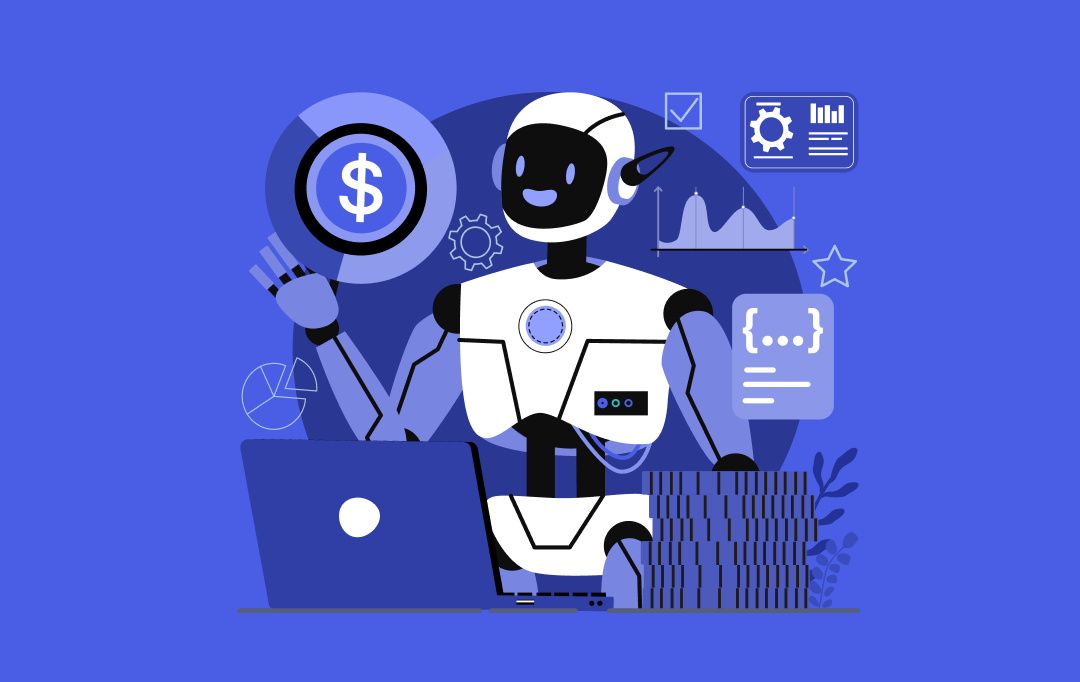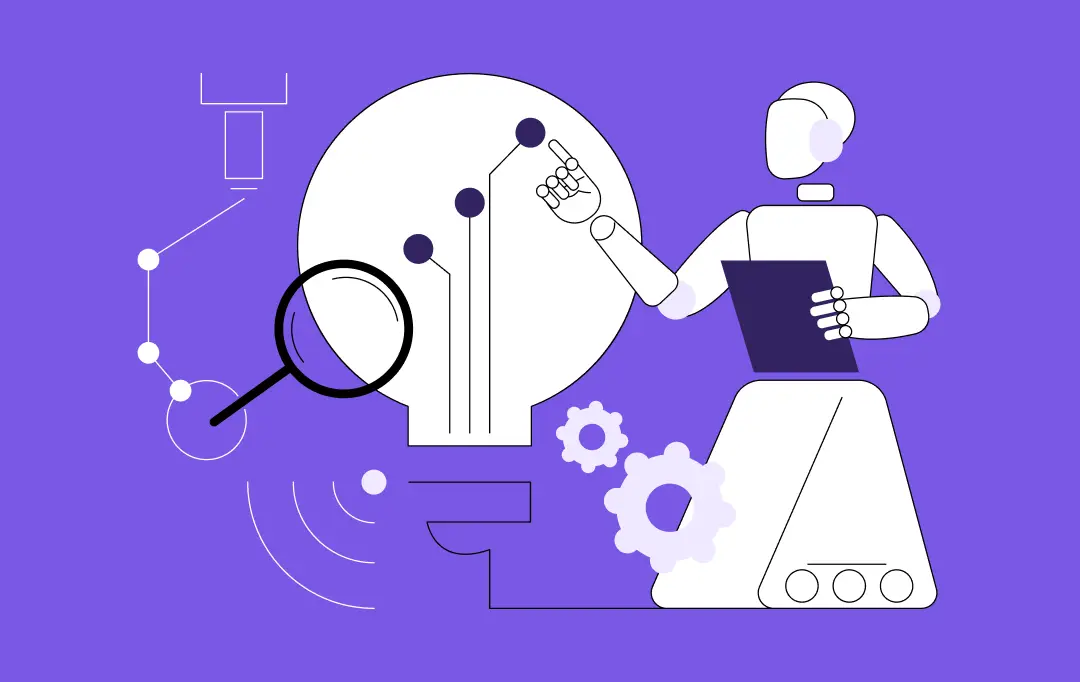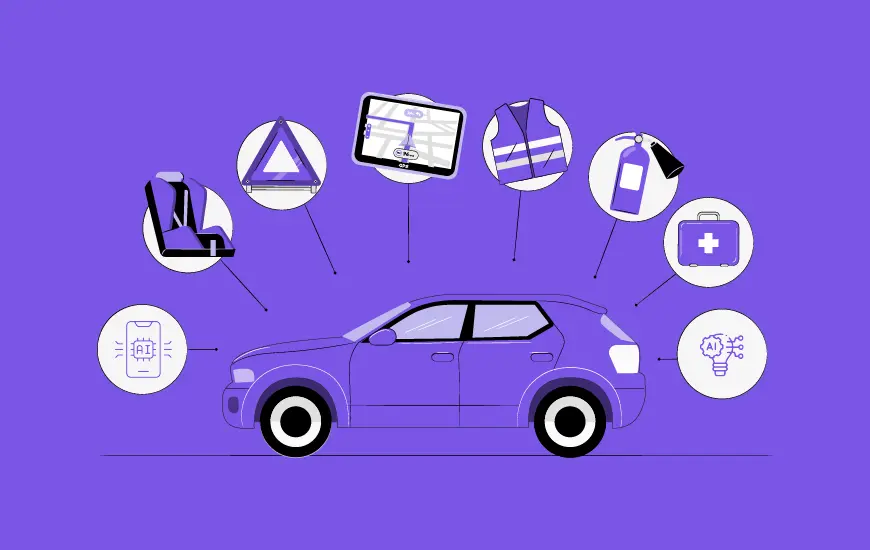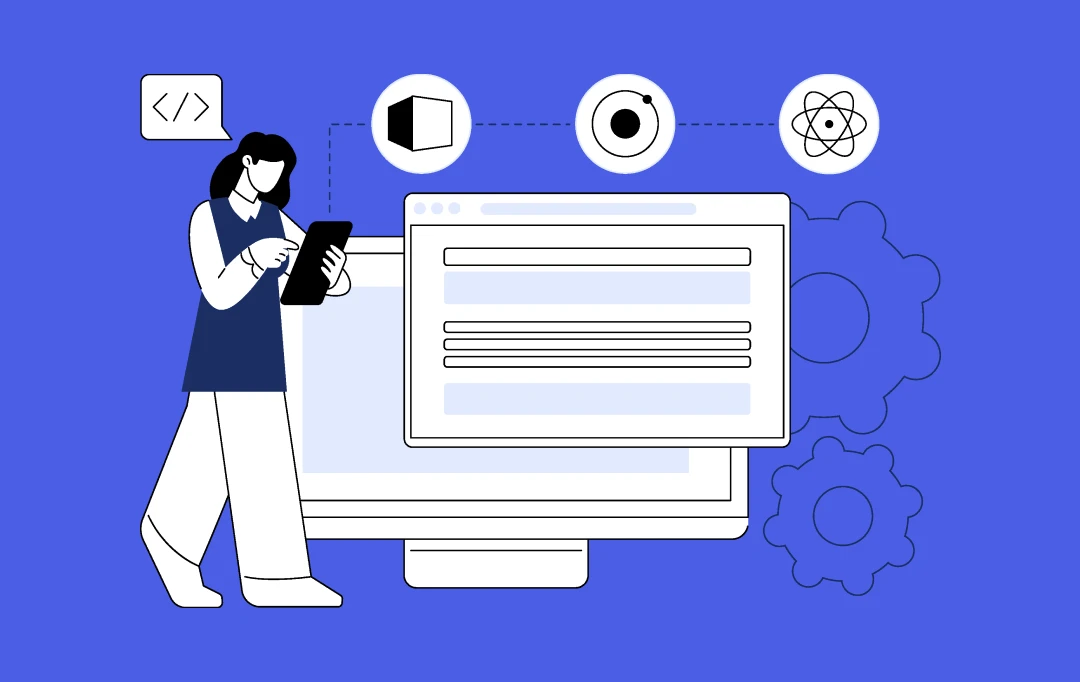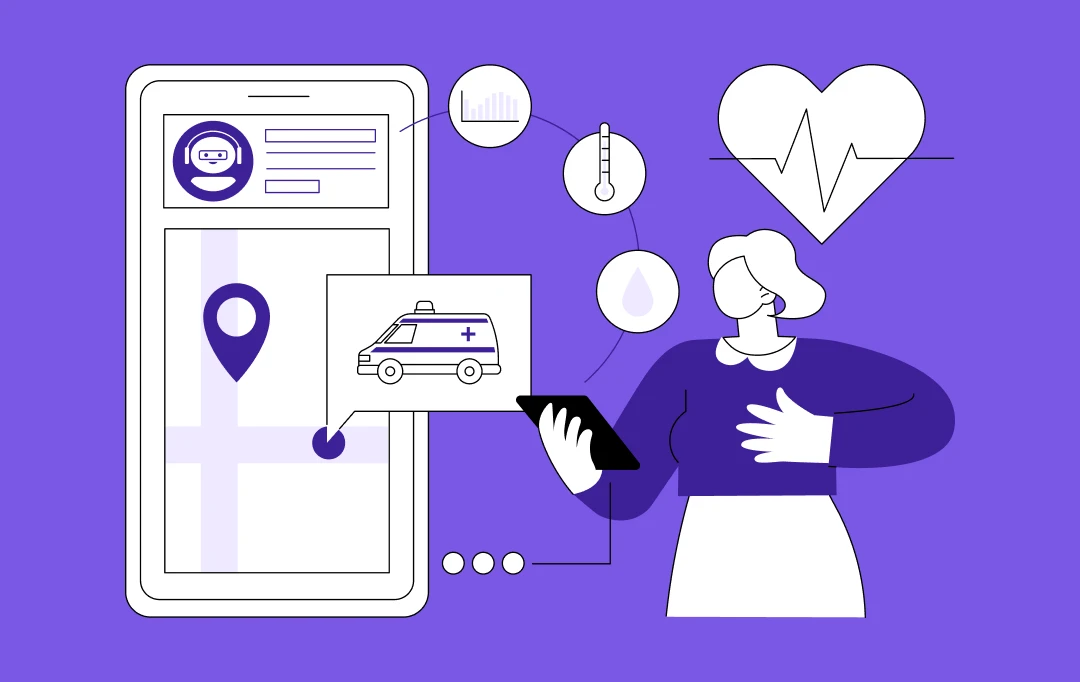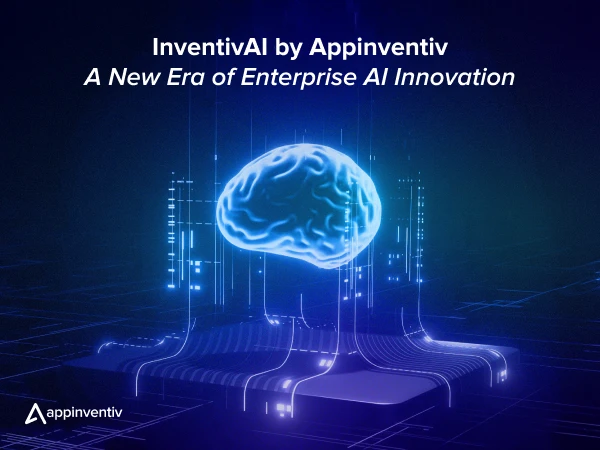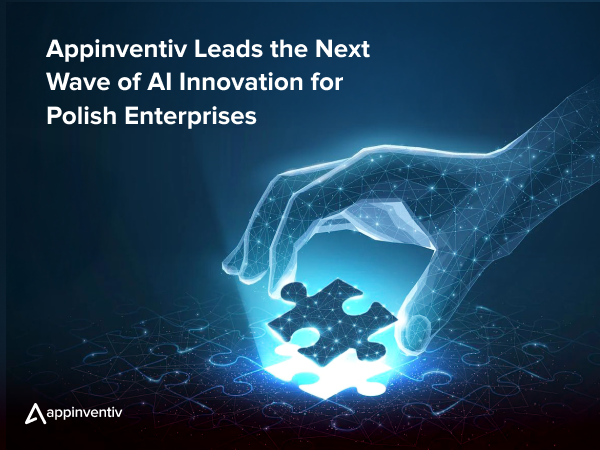- The Evolution of AI in Gaming: From Scripted Moves to Systems That Learn
- Key Types of AI in Gaming: Picking the Right Brains for Your Game
- Rule-Based AI
- Machine Learning AI
- Finite State Machines (FSMs)
- Behavior Trees (BTs)
- Pathfinding AI
- Reinforcement Learning AI
- Generative AI
- Neural Networks and Deep Learning
- Benefits of AI in Game Development: Faster Builds, Smarter Decisions, Happier Players
- 1. Faster and Smarter Production
- 2. Better Player Engagement
- 3. Reduced Development Cost
- 4. Improved Game Quality and Testing
- 5. Data-Driven Game Design
- 6. Creativity and Innovation at Scale
- 7. Cross-Platform Optimization
- 8. Long-Term Player Retention
- Use Cases of AI in the Gaming Industry: Real Problems, Real Wins
- 1. Smarter Non-Player Characters (NPCs)
- 2. AI Image Enhancement and Upscaling
- 3. Procedural Content Generation (PCG)
- 4. Player-Experience Modeling (PEM)
- 5. Data Mining and Real-Time Analytics
- 6. Player Sentiment and Community Analysis
- 7. Cheat Detection and Fair Play
- 8. Automated Testing and Debugging
- 9. AI-Driven Virtual Assistants
- 10. AI in AR/VR and Mixed Reality
- 11. Dynamic Audio and Voice Synthesis
- 12. AI-Powered Monetization and Personalization
- 13. Accessibility and Inclusivity
- 14. AI-Enabled Live-Ops and Game Balancing
- 15. AI for Narrative Design and Storytelling
- 16. AI for Game Localization and Real-Time Translation
- 17. AI for Player Support and Moderation
- Cutting-Edge Breakthroughs Redefining AI in Game Development: The Tech That Will Set Tomorrow’s Hits Apart
- How to Implement AI in Gaming: A Practical Path from Pilot to Production
- Strategic Planning and Goal Setting
- Technology and Tool Selection
- Data Infrastructure and Pipeline Setup
- Design and Production Integration
- Testing, Deployment, and Continuous Optimization
- Governance and Responsible AI Implementation
- Challenges and Ethical Considerations in AI-Driven Game Development
- The Human Touch: Balancing AI and Creativity
- Why Creative Oversight Still Matters
- Collaborative Workflows That Actually Work
- Maintaining Control in an Automated Age
- Cost of AI-Powered Game Development: What Drives the Budget
- The Future of AI in Game Development: Trends That Will Reshape Play, Production, and Profit
- Smarter AI Agents and Self-Learning Systems
- Seamless Integration Across Platforms
- Adaptive Storytelling and Real-Time Worlds
- Ethical Design and Transparent Systems
- Collaborative Creation Between Humans and Machines
- Decentralized Game Economies and AI-Driven GameFi
- Real-Time Generative Environments and Interactive Video Engines
- Advanced Accessibility and Inclusivity Systems
- Sustainability and AI-Optimized Development Pipelines
- Why Appinventiv Is the Right Partner for Your AI-Powered Gaming Vision
- FAQs
Key takeaways:
- AI has become the creative engine behind today’s most successful games.
- Intelligent automation is redefining how teams design, test, and scale.
- Generative AI is turning imagination into production at record speed.
- Emotion-aware gameplay is pushing personalization to new heights.
- Predictive analytics is helping developers fine-tune player experiences in real time.
- Cloud and edge-based AI systems are making cross-platform gaming seamless.
- Ethical, transparent AI use is now a business advantage, not a compliance checkbox.
- The cost of AI-powered game development depends on scale, depth, and live learning.
Let’s be honest- if you’re still debating whether to use AI in your gaming business, you’re already behind the curve. The conversation has shifted from “should we adopt it?” to “how fast can we integrate it across our pipelines?”
Artificial intelligence isn’t just enhancing the gaming experience anymore but it is essentially becoming the backbone of modern game development. From creating intelligent NPCs that think on their own to generating entire worlds in real time, AI in game development is changing how businesses and studios build, test, and scale games.
The numbers make it clear: in 2025, the AI in gaming industry has crossed $3,280.9 million in 2024 in annual revenue, powered by a gamer base that’s now over 3.3 billion strong. And behind the scenes, more than 90% of developers are already using AI to automate production, personalize gameplay, and unlock creative possibilities that human teams alone simply can’t keep up with.
What’s driving this momentum? A few big shifts like generative AI that creates infinite stories and assets on demand, cloud streaming that makes high-end experiences accessible anywhere, emotion-aware systems that respond to player moods, and real-time analytics that adapt every interaction. Together, they’re rewriting the rules of engagement, monetization, and even storytelling itself.
This blog dives deep into that transformation. You’ll see how AI is redefining every corner of the gaming industry, from development and design to player experience and business growth. We’ll unpack where the biggest opportunities lie, what technologies are shaping the next era, and how forward-thinking studios are already acting on them. Because in 2025, success in gaming isn’t about asking “why AI?” but about mastering “how fast you can make it work for you.”
With the market crossing half a trillion dollars, this is the moment to act, not watch.
The Evolution of AI in Gaming: From Scripted Moves to Systems That Learn
If you look back, gaming has always been an early adopter of intelligence, just not always artificial. It started with predictable, rule-based systems where every move was scripted and every outcome pre-defined by human logic. Early arcade bots and chess engines could react but not reason. Yet that simplicity laid the groundwork for today’s transformation – a shift from static design to adaptive, self-learning intelligence that can think, respond, and even create.
The real turning point came when machines began learning from experience. IBM’s Deep Blue defeating Garry Kasparov in 1997 was the world’s first glimpse of computational strategy outperforming human intuition. Nearly two decades later, Google’s AlphaGo pushed the boundary further in 2016, mastering a game of infinite possibilities once thought impossible for machines. These moments weren’t just wins in gameplay; they were breakthroughs that redefined how we perceive intelligence in digital systems.
The next leap arrived with games like AI Dungeon, No Man’s Sky, and Minecraft’s mod ecosystems, platforms that let players co-create worlds rather than just play them. Here, AI blurred the lines between designer and gamer. Machine Learning algorithms began shaping outcomes dynamically, crafting quests, dialogues, and maps in real time. In fact, Minecraft, with over 200 million active players monthly, and No Man’s Sky, which has surpassed 12 million global players years ago, represent what happens when human creativity meets adaptive algorithms, leading to limitless replayability.
By the end of 2025, AI in gaming has gone far beyond clever NPCs or auto-generated levels. With generative AI, text-to-3D modeling, and LLM-driven storytelling, developers can now generate entire game environments, narratives, and assets on demand.
Businesses like Ubisoft, EA, and Riot Games are already deploying AI-powered creative assistants that script dialogue, populate open worlds, and even balance combat mechanics in real time. These tools don’t replace human creativity but amplify it, cutting production timelines and enabling deeper personalization for millions of players.
The growth of this innovation is mirrored by the scale of the industry itself. According to Grand View Research, the global gaming market’s revenue is expected to climb to $51,259.3 million by 2033, growing at a CAGR of 36.1% from 2025 to 2033. This growth is being driven not just by console and mobile games but also by AI-enhanced AR and VR experiences.
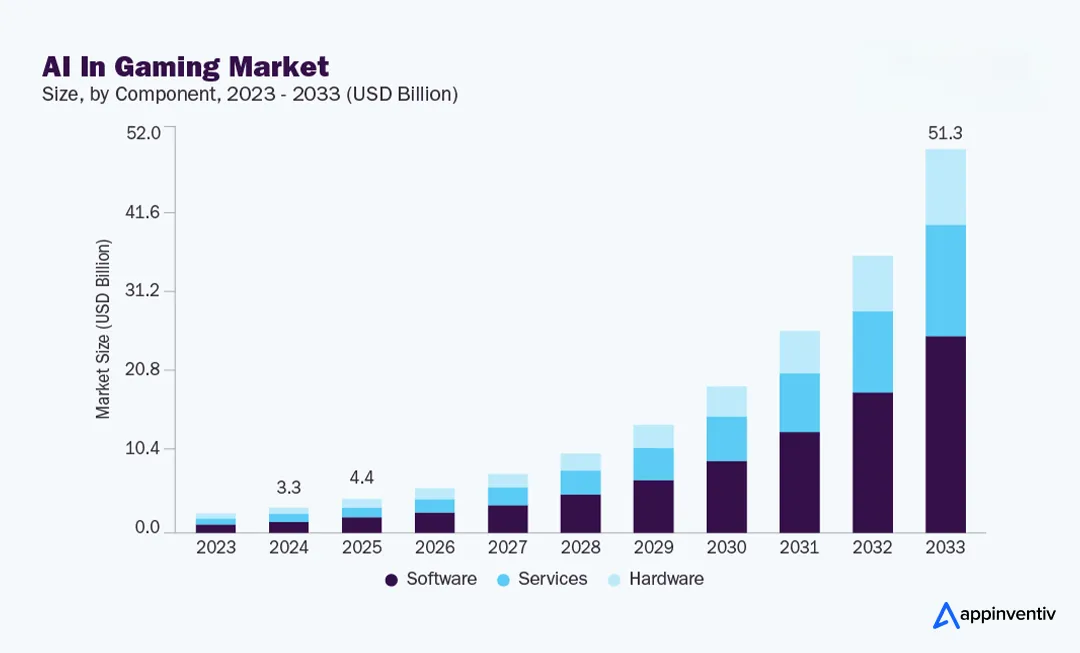
As per IDC’s 2025 industry forecast, gaming dominates the software and services spend across AR/VR ecosystems, with titles like Animal Company, Beat Saber, and Gorilla Tag ranking among the top-grossing games of the year. Spending on AR/VR apps and services is projected to rise 19.7% in 2025, reaching nearly $12 billion worldwide.
These figures tell a clear story – AI is no longer a supplement to the gaming experience; it’s the infrastructure powering its future. From adaptive gameplay to generative design, from player modeling to virtual economies, intelligence has become the most valuable asset in a developer’s toolkit. The question is no longer “Can AI make gaming better?” but “How far can it take us?”
2025 marks the moment that distinction fades entirely, where game development no longer revolves around what we can code, but what we can train. The result: an industry entering its most intelligent, immersive, and profitable era yet.
Key Types of AI in Gaming: Picking the Right Brains for Your Game
AI and gaming have grown side by side for decades. Every leap in AI in game development has opened a new way to make games think, move, and respond. Today, most studios use a mix of old logic systems and modern learning models to shape how players experience the world around them. Understanding these types of artificial intelligence in gaming helps teams pick the right balance between control and creativity.
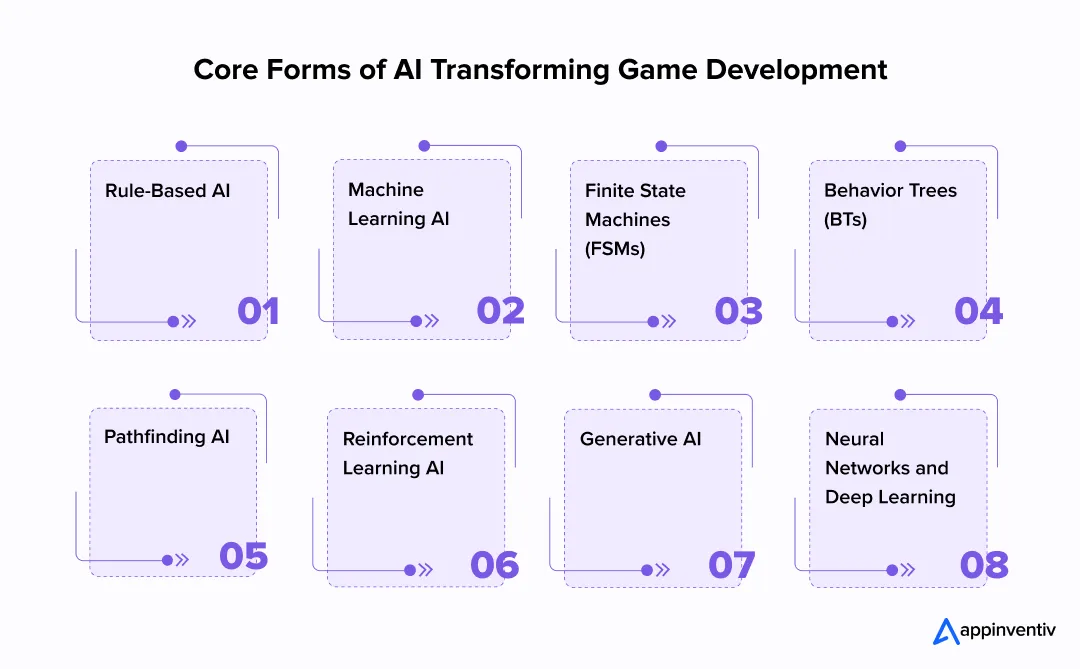
Rule-Based AI
This is the simplest form of AI in video games. Developers set clear instructions – if one thing happens, another follows. It keeps characters predictable and makes the game easier to tune.
Machine Learning AI
Here, the system studies patterns and adjusts on its own. It looks at how players behave and reshapes its response over time. It’s the first real step from coded behavior to learning behavior in AI for game development.
Finite State Machines (FSMs)
Finite state systems divide game logic into small pieces. Each state handles one behavior – waiting, attacking, retreating and the AI jumps between them as needed. It keeps structure without losing flexibility.
Behavior Trees (BTs)
Behavior trees organize actions like a checklist. Each branch tells the AI what to try first, what to repeat, and when to stop. Many modern projects use them because they’re easy to read and expand.
Pathfinding AI
Movement is where artificial intelligence in game development meets geometry. Pathfinding algorithms let characters move through complex terrain, find shortcuts, and react when obstacles appear. It’s the silent logic behind smooth navigation.
Reinforcement Learning AI
This type of AI in the gaming industry learns through trial and error. It tests, fails, and slowly improves until it finds what works best. It’s often used when designers want truly adaptive behavior instead of fixed routines.
Generative AI
Generative systems are the newest addition to AI applications in game development. They can create levels, art, and dialogue on their own using prompts or context. It saves time, but more importantly, it expands what a small team can build.
Neural Networks and Deep Learning
Deep learning sits at the heart of today’s artificial intelligence in video games. It helps systems see patterns too complex for human rules, reading intent, predicting action, and even mimicking creative decisions. It’s what gives modern games that extra sense of life.
Benefits of AI in Game Development: Faster Builds, Smarter Decisions, Happier Players
AI has quietly changed how studios build, test, and grow their games. What once took large teams and long timelines can now be done faster and with more precision. The real value of AI in gaming isn’t only in what it automates but how it frees businesses to focus on creativity. When used wisely, artificial intelligence in game development helps studios make smarter decisions, reduce risk, and deliver better player experiences. Let’s understand the benefits of AI for game development in detail below:

1. Faster and Smarter Production
AI helps studios cut through long design cycles. It handles time-heavy work like animation cleanup, asset tagging, and level balancing so teams can move ideas from concept to screen much faster. For growing companies in the AI in game development market, this speed often decides who launches first.
2. Better Player Engagement
Modern AI in the gaming industry makes gameplay more personal. It studies what players enjoy, tracks difficulty preferences, and shapes experiences that keep people coming back. Games feel less mechanical and more reactive, improving both satisfaction and retention.
3. Reduced Development Cost
Every hour saved by automation lowers cost. As AI tools for game development become more common, studios can achieve the same results with smaller teams. This efficiency matters most for independent developers or mobile studios competing against large publishers.
[Also Read: Intelligent Automation: How should Enterprises get Started?]
4. Improved Game Quality and Testing
Artificial intelligence can test thousands of gameplay paths at once. It finds bugs, balance issues, and design flaws before they reach the player. This keeps releases stable and protects a brand’s reputation- a key advantage of AI in game development that pays off long after launch.
5. Data-Driven Game Design
AI turns gameplay data into clear insights. Developers can see how users interact, where they lose interest, or what keeps them hooked. This feedback loop helps refine updates and shape sequels that match real player behavior.
6. Creativity and Innovation at Scale
The rise of generative AI in gaming has widened what’s possible. Artists and writers can experiment with new worlds, characters, or storylines without being limited by resources. It’s not about replacing talent but giving creative teams more room to explore.
7. Cross-Platform Optimization
AI can tailor visuals, controls, and performance for different devices. In AI in mobile game development, this means smoother experiences across a range of hardware without manual adjustments. It lets studios reach larger audiences with consistent quality.
8. Long-Term Player Retention
With adaptive content and predictive insights, AI in video game development helps businesses understand when players might lose interest. Early detection allows teams to add new challenges, events, or stories before engagement drops.
Use Cases of AI in the Gaming Industry: Real Problems, Real Wins
Artificial intelligence didn’t just slip into gaming but grew into it. At first, it was a novelty: smarter bots, better graphics, faster loading. Now it’s quietly running the show. Every major studio uses it somewhere – inside the game, behind the servers, or in the design lab. AI isn’t about replacing the spark of creativity; it’s about stretching what that spark can do. Let’s look into the top uses for AI in the gaming industry in detail below:
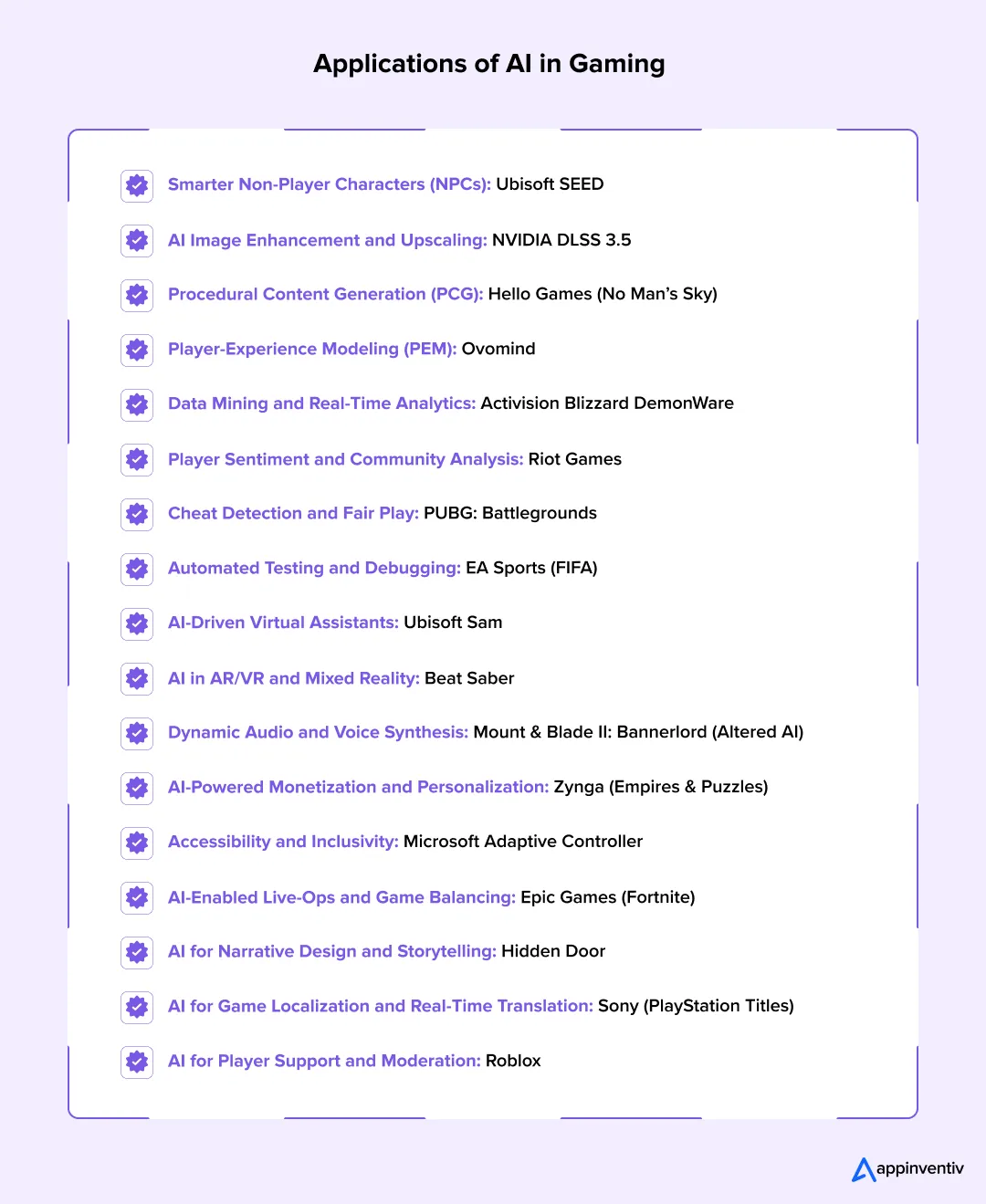
1. Smarter Non-Player Characters (NPCs)
NPCs used to walk the same route, say the same line, and forget you existed the moment you turned away. Not anymore. Today’s NPCs can react to how you play, remember what you did, and change tactics if you catch them off guard. They act less like code and more like cast members in an unscripted story.
Example: Ubisoft’s SEED division has been training its NPCs using player-behavior data. The AI studies how real people move and fight, then builds opponents that learn from each encounter. You can’t predict them anymore and that’s the fun part.
2. AI Image Enhancement and Upscaling
Gamers notice when a frame stutters or a texture looks muddy. Upscaling tools powered by AI have quietly fixed that. They rebuild missing detail, sharpen lighting, and make older machines feel new again. It’s the difference between a game that looks dated and one that still feels alive.
Example: NVIDIA’s DLSS 3.5 does this in Cyberpunk 2077 and Alan Wake 2. It guesses what the next frame should look like, then paints it faster than a graphics card could on its own. Players get smoother visuals without needing the latest hardware.
3. Procedural Content Generation (PCG)
Every open-world developer knows how exhausting it is to build new maps by hand. AI now handles part of that heavy lifting. It creates landscapes, fills them with creatures, even drops in a story hook or two. The result: bigger worlds, shorter timelines.
Example: The team at Hello Games built No Man’s Sky around this idea. Their algorithms mix terrain, atmosphere, and biology to produce over 18 quintillion planets. No designer could ever finish that by hand and that’s kind of the point.
4. Player-Experience Modeling (PEM)
Some players want a challenge. Others just want to relax after work. AI figures that out by watching how you play, how fast you move, when you hesitate, when you quit. Then it reshapes the game in quiet ways: a slower enemy here, an extra health pack there.
Example: Ovomind, a small AI studio, built an emotion-tracking system that listens to your heart rate and response time. When it senses tension, it softens the background or eases the difficulty. When you’re in flow, it pushes harder. It feels personal, not programmatic.
5. Data Mining and Real-Time Analytics
Modern games generate oceans of data like scores, clicks, server pings, chat logs. Hidden inside that noise are clues about what keeps players hooked. AI digs through it all in seconds and gives studios the patterns they need to fix problems fast.
Example: Activision Blizzard’s DemonWare division uses these analytics to keep Call of Duty running smoothly. The system predicts where servers might buckle, reroutes traffic, and even fine-tunes matchmaking while you play.
6. Player Sentiment and Community Analysis
Players talk on Reddit, Discord, TikTok and that feedback can make or break a title. AI tools read through that mountain of chatter and pick out the mood behind it. Developers finally get an honest pulse instead of guesswork.
Example: Riot Games leans on language-processing models to track how the League of Legends community feels after every patch. When frustration spikes, they know exactly which mechanic to revisit. It’s like having a 24-hour focus group without the bias.
7. Cheat Detection and Fair Play
Cheating has always been gaming’s ugly side. Traditional detection can’t keep up, but AI watches how people actually play, not just what they click. It spots patterns a human moderator would miss.
Example: PUBG: Battlegrounds uses AI to review billions of player movements every day. When someone’s reactions look impossible, the system steps in. Thousands of accounts vanish each week, and honest players barely notice the cleanup.
8. Automated Testing and Debugging
Testing used to be endless repetition: play, crash, report, repeat. Now AI bots can do that work overnight. They stress every button, every wall, every weather pattern, then hand a list of what broke. Developers fix, retest, move on.
Example: EA’s sports division uses this method on FIFA. Their AI testers play millions of matches, looking for odd physics or missing collisions. What once took weeks now finishes before Monday morning.
9. AI-Driven Virtual Assistants
Game worlds can be confusing. Instead of flipping through menus, players can now ask for help. AI assistants explain mechanics, track progress, or suggest what to try next like having a friendly guide inside the game.
Example: Ubisoft’s Sam does exactly that. You can ask it why you lost a match or what mission you skipped, and it answers like a teammate who actually remembers your stats.
10. AI in AR/VR and Mixed Reality
Virtual reality has no patience for lag. AI helps predict where a player’s head or hands will move next, keeping the world in sync with real life. It’s what makes motion feel natural instead of nauseating.
Example: In Beat Saber, AI predicts each swing milliseconds before it happens, aligning the beat perfectly. That’s why the rhythm feels so tight, even at breakneck speed.
[Also Read: 15 Use Cases on How AI Is Transforming Virtual Reality: The Future of Immersive Experiences]
11. Dynamic Audio and Voice Synthesis
Sound sets the mood more than visuals sometimes. AI can now write music that shifts with the action or generate voice lines that change based on what you’ve done. It makes stories feel spontaneous.
Example: Mount & Blade II: Bannerlord is one of the leading examples of artificial intelligence in games that uses Altered AI’s tools to create authentic character voices without recording hundreds of actors. Dialogue sounds fresh, even when you’ve heard it before.
12. AI-Powered Monetization and Personalization
Instead of throwing random offers at players, studios now let AI watch how people spend time and money. The system suggests rewards that actually make sense for each person.
Example: Zynga runs predictive models in Empires & Puzzles that adjust offers based on player habits. Someone who prefers cosmetics gets those first; someone else sees progression boosts. It feels tailored, not manipulative.
13. Accessibility and Inclusivity
AI is quietly rewriting who gets to play. It interprets gestures, voice commands, and small physical inputs so that players with disabilities can join in without barriers.
Example: Microsoft’s Adaptive Controller, built with AI input mapping, learns how each player moves and remaps buttons accordingly. It opened mainstream gaming to thousands who were previously locked out.
14. AI-Enabled Live-Ops and Game Balancing
For games that never really “end,” balance is everything. AI models test future updates in advance, spotting problems before players ever notice them.
Example: Epic Games runs machine simulations of upcoming Fortnite seasons. The AI predicts how new weapons might shift win rates and helps designers tweak stats long before launch day.
15. AI for Narrative Design and Storytelling
AI has started lending a hand to writers. It helps build dialogue trees that branch naturally and fill gaps in massive storylines. The result feels less linear and more alive.
Example: Hidden Door’s storytelling engine lets players co-create adventures with AI. It responds to tone and word choice, turning simple prompts into full conversations or side quests that make sense.
16. AI for Game Localization and Real-Time Translation
Big studios can’t wait months to translate every script. AI handles the bulk of it – text, dialogue, even slang and checks cultural context so jokes still land.
Example: Sony uses neural translation tools for PlayStation titles, pushing multi-language updates on the same day worldwide. Players in Japan, Brazil, and France start at the same moment.
17. AI for Player Support and Moderation
Community health makes or breaks online games. AI now patrols voice and text chats in real time, cutting off harassment before it spreads.
Example: Roblox runs deep-learning filters that flag toxic messages instantly. Players rarely notice, but the chat stays civil, and younger audiences stay safe.
[Also Read: How Much Does It Cost to Build a Gaming Platform Like Roblox?]
Now that you’ve seen how AI is being used across gaming, it’s worth asking what comes next. Businesses that build or publish games can’t afford to stop at today’s applications but need to understand where the next big shifts are forming. The real advantage lies in seeing what’s around the corner before it becomes mainstream. That’s where the upcoming breakthroughs matter – they hint at the tools, systems, and ideas that will shape how studios work, how players engage, and how the entire market grows.
Cutting-Edge Breakthroughs Redefining AI in Game Development: The Tech That Will Set Tomorrow’s Hits Apart
AI in gaming is moving past the stage of experimentation and into full-scale transformation. The next phase of artificial intelligence in game development is about creating systems that can imagine, design, and react as fluidly as the players themselves. These innovations are giving rise to smarter environments, faster production cycles, and completely adaptive gameplay experiences.
Below are some of the most promising breakthroughs that show where AI in the gaming industry is heading and why understanding them early gives businesses a competitive edge.
| Breakthrough Area | What’s Changing | Example | Why It Matters for Businesses |
|---|---|---|---|
| Generative AI in Gaming | Generative AI is reshaping how developers build worlds, characters, and narratives. Instead of spending months modeling assets, AI tools can generate 3D objects, storylines, or even level layouts in minutes. | Inworld AI and Scenario let designers describe a setting in plain language, and the AI instantly builds playable game environments. | Reduces development cost and time, helping studios scale content faster. It’s a major advantage in a crowded game development market. |
| Emotion-Aware Gameplay Systems | Games are starting to respond to a player’s emotions in real time. Using biometric data and facial recognition, AI adjusts the pace, music, and difficulty based on how the player feels. | Ovomind integrates emotion-sensing AI in video games, changing difficulty levels and background tones to match player mood. | This kind of AI in video game development deepens engagement and keeps players emotionally connected, extending session time and retention. |
| AI-Powered Cloud and Edge Optimization | Cloud-based AI systems now handle rendering and load balancing dynamically. By predicting network stress and user behavior, they maintain smooth gameplay across platforms. | NVIDIA GeForce Now and Xbox Cloud Gaming use predictive AI tools for game development to improve performance in real time. | Reduces latency and lowers hardware dependency, a key cost-saving factor for both developers and players. |
| Intelligent AR, VR, and Mixed Reality Experiences | Artificial intelligence in gaming is driving the rise of responsive VR worlds. AI handles spatial mapping, motion prediction, and real-world object detection, making immersive experiences feel natural. | Meta Horizon Worlds and Niantic Lightship rely on AI to map environments and populate them with adaptive, player-driven interactions. | Enhances user immersion and unlocks new revenue channels in AI for game development, especially for hybrid AR/VR studios. |
| Dynamic Storytelling Through AI Agents | AI agents in game development can now co-write or adapt stories during gameplay. They analyze decisions, relationships, and tone to deliver branching narratives. | Hidden Door uses generative AI in video games to let players co-create dialogues and storylines in real time. | Adds longevity and replay value, giving developers new creative control without increasing team size or cost. |
| AI for Accessibility and Inclusion | The advantages of AI in game development extend to accessibility. Adaptive systems now translate languages, map alternative controls, and narrate on-screen elements instantly. | Microsoft’s Adaptive Controller powered by Azure AI personalizes control schemes based on player movement range. | Expands the player base and builds stronger brand reputation through inclusive AI solutions for game development. |
| AI-Generated Soundscapes and Voice Design | Artificial intelligence in video games now extends to audio, creating ambient music and lifelike voices on demand. | Altered AI and AIVA compose dynamic scores and natural dialogue that adjust to gameplay. | Reduces production time while improving sound quality, a major benefit of AI for game development in immersive titles. |
| Predictive Game Balancing and Live-Ops | AI models can forecast the effects of new patches, updates, or weapons before release, preventing gameplay imbalance. | Epic Games applies AI applications in game development to test Fortnite updates virtually before pushing them live. | Minimizes patch errors and keeps player trust intact which is crucial for long-term live service games. |
How to Implement AI in Gaming: A Practical Path from Pilot to Production
Bringing AI in game development into a studio’s workflow takes more than plugging in a model. It’s a shift in how teams design, test, and release. The aim is to use artificial intelligence in gaming to make smarter systems, shorten timelines, and add depth to player experiences, while keeping creative direction intact.
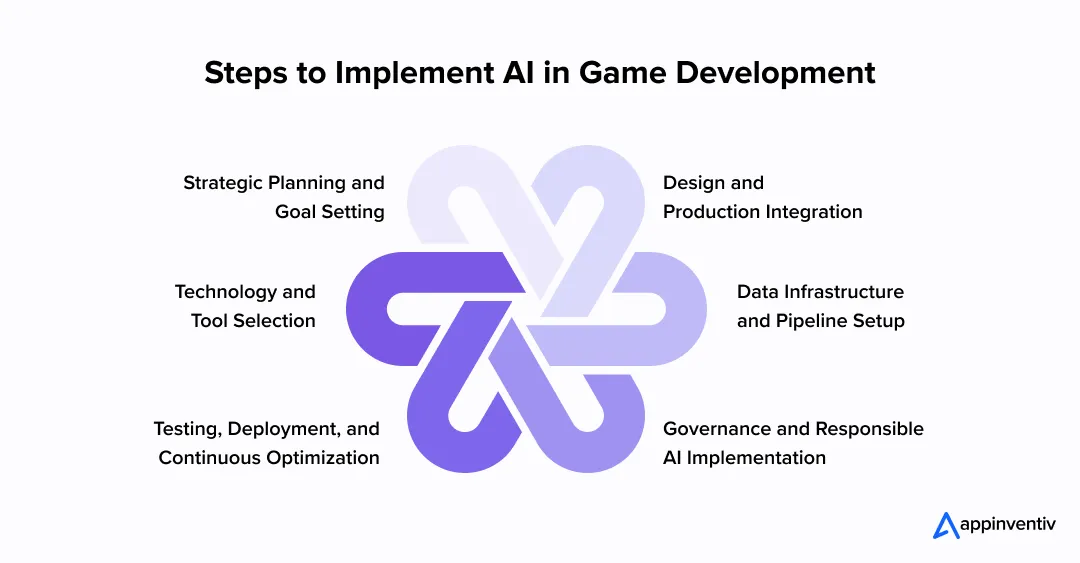
Strategic Planning and Goal Setting
Every AI initiative starts with a reason. Decide what problem you’re solving, such as faster QA, better personalization, or more dynamic storytelling. Keep these goals specific and trackable. When AI for game development ties to a clear outcome, it becomes part of the roadmap, not a side experiment.
Technology and Tool Selection
Once the goals are clear, look at your toolkit. Engines like Unity and Unreal already support machine-learning agents, procedural generation, and adaptive animation. Add-ons such as NVIDIA DLSS, AWS GameLift, or custom APIs can extend what’s possible. The best AI tools for game development are those that fit your pipeline and the skills your team already has.
Data Infrastructure and Pipeline Setup
AI thrives on clean, consistent data. Building a secure pipeline for player telemetry, testing logs, and gameplay analytics is the backbone of any reliable system. Cloud-based training environments and lightweight edge inference models help games respond instantly. Strong data foundations make AI applications in game development scalable and dependable.
Design and Production Integration
AI should join the creative process early. In the design phase, it can assist with procedural world-building, adaptive dialogue, and texture generation. During production, it supports animation smoothing, difficulty tuning, and automated bug testing. Embedding artificial intelligence in game development this way keeps teams creative without slowing delivery.
Testing, Deployment, and Continuous Optimization
Games change once players touch them. Testing AI systems in controlled environments helps catch errors before they spread. Continuous learning models can adapt to live feedback, improving performance over time. This ongoing tuning keeps AI in the gaming industry balanced and responsive as audiences grow.
Governance and Responsible AI Implementation
With great automation comes responsibility. Studios must handle player data with transparency, explain how AI decisions affect gameplay, and maintain a clear review process. These steps protect both users and the studio’s reputation. In a fast-moving game development market, ethical design isn’t a trend but survival.
Challenges and Ethical Considerations in AI-Driven Game Development
As more businesses are using AI in game development, new problems appear alongside the progress. Some are technical like bias, data accuracy, system transparency while others are human, such as how players feel about being observed or guided by algorithms. These challenges affect how people trust artificial intelligence in gaming, how regulators see it, and how studios protect creativity while using automation.
Understanding these risks early helps teams design guardrails before they scale. Below are the main hurdles facing modern AI in the gaming industry, their real impact on production and players, and how responsible studios can address them.
| Challenge | Impact | Possible Solution |
|---|---|---|
| Data Privacy and Consent | Collecting player data for AI systems raises privacy concerns, especially when telemetry or voice data is stored for training. Poor handling can break trust and violate local laws. | Create transparent consent options. Store only what is needed, anonymize wherever possible, and align with regional data rules such as GDPR or CCPA. Make privacy settings easy to find in every build of the game. |
| Bias and Fairness in AI Models | Algorithms trained on narrow datasets can produce uneven difficulty, cultural bias, or stereotyping in characters. It harms inclusivity and weakens global appeal. | Diversify data sources, test across varied audiences, and include human review panels. Responsible AI tools for game development must represent broad player behavior. |
| Over-Automation and Loss of Creativity | Heavy dependence on artificial intelligence in game development can flatten artistic expression. Designers may rely on generated assets instead of original design. | Keep creative checkpoints. Let artists approve, edit, or reject AI-generated material. Use automation for speed, not imagination. |
| Unclear Ownership of AI-Generated Content | Generative AI in gaming creates legal questions around who owns new textures, sound, or dialogue. This can delay releases or licensing deals. | Maintain internal guidelines that define authorship and usage rights. Track all AI-generated assets within a studio ledger to prove creative ownership. |
| Player Manipulation and Behavioral Targeting | AI-based personalization can push engagement too far, nudging players into addictive loops or aggressive spending. | Use AI applications ethically by setting engagement caps and publishing fairness policies. Balance retention design with player well-being. |
| Security and Model Exploitation | Hackers can reverse-engineer machine-learning models or exploit online matchmaking logic. This threatens multiplayer integrity. | Combine AI monitoring with human moderation. Run penetration tests regularly. Keep sensitive model parameters on secure servers rather than client-side. |
| Lack of Transparency in AI Decisions | When AI adjusts difficulty or bans accounts, players may not know why. This damages trust and community reputation. | Provide clear feedback. Explain automated actions in accessible language. Maintain a manual appeal path for any AI-driven moderation. |
| Regulatory Uncertainty and Compliance | The AI game development market is now drawing attention from global regulators. Different regions demand different disclosures. | Track new AI and data regulations early. Assign compliance leads who coordinate with legal teams before shipping global builds. |
| Sustainability and Compute Costs | Training and maintaining large models consume vast energy. Smaller studios can’t afford the infrastructure. | Use pre-trained or shared models where possible. Optimize compute cycles and rely on cloud vendors offering green energy credits. |
After looking at the challenges and risks around AI, it’s clear that technology alone isn’t enough. What comes next is understanding how people and machines can work together without losing what makes games human. The next step is balance, keeping creativity at the center while using AI as a partner, not a replacement. That’s where the real long-term value lies for studios that want to grow without losing their identity.
The Human Touch: Balancing AI and Creativity
AI may be the driving force behind modern game production, but it’s people who give those worlds life. Every great story, every memorable character, every emotional beat still begins in human imagination. Studios pushing deeper into automation often learn the same lesson – real success comes from balance, not substitution. The spark that connects design to emotion can’t be automated. Lose that, and even the most advanced technology starts to feel empty.
For business leaders, this isn’t a question of sentiment but a matter of longevity. Games that lack human touch fade quickly. Players might admire the polish but not stay for the heart. The businesses that stand out are the ones using AI for what it does best, which is scale, speed, and precision, while keeping creative control firmly in human hands. A collaborative process that includes people at every stage makes production efficient without losing its soul.
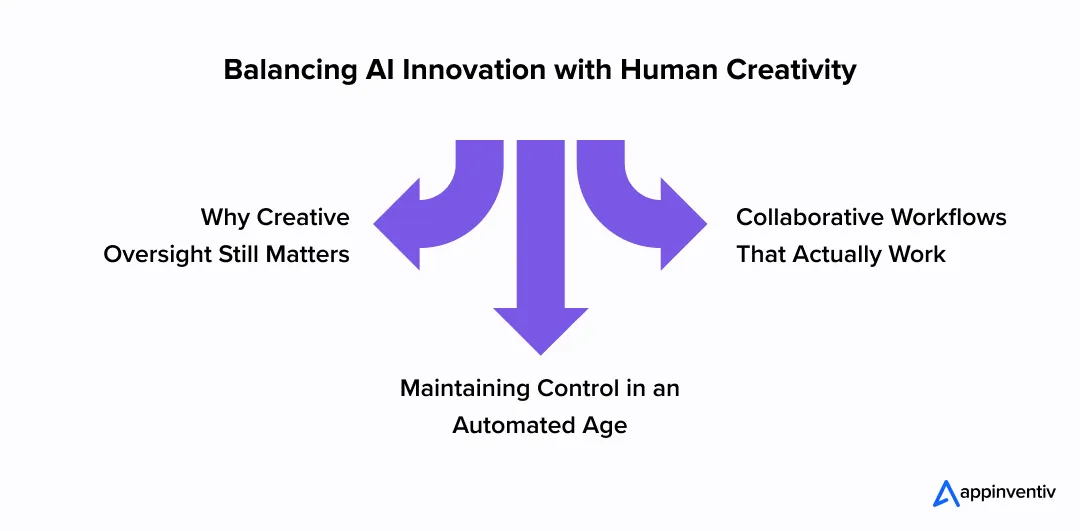
Why Creative Oversight Still Matters
Automation can fill in the blanks, but it can’t read a player’s emotion or understand why a story moves someone. Generative systems can produce dialogue or music that sounds fine on paper, but meaning comes from judgment, the kind only humans bring. When creative leads stay involved, reviewing and reshaping what AI creates, the work retains its identity. It feels intentional, not generated. That oversight is what keeps a studio’s voice consistent and recognizable across every release.
Collaborative Workflows That Actually Work
The smartest studios are learning how to let humans and AI share the desk. Machines handle drafts, textures, or early animations; teams refine, edit, and breathe life into them. It’s a back-and-forth rhythm that turns AI into a creative companion instead of a silent worker. This balance speeds up delivery, yes, but more importantly, it keeps the process playful – a place where artists and writers still feel ownership over what they make.
Maintaining Control in an Automated Age
Some of the biggest names in gaming have already built systems to protect creative ownership. Teams at Ubisoft and Electronic Arts keep human approval at the center of every AI workflow. Designers test AI ideas before they scale. Writers adjust tone and context before anything goes live. Producers have the final word. These checks aren’t barriers; they’re anchors. They make sure that, no matter how smart the systems become, the heart of each project still beats with human intent.
For newer businesses entering a world built on automation, that mindset is more than a safeguard but a promise. Technology can help a studio build faster, but only creativity keeps it relevant. The future of gaming belongs to teams that use AI wisely, not blindly.
As you look deeper into AI-driven production, one question always comes up – how much does it really cost to build something like this? The answer depends on how ambitious the project is, how complex the AI systems are, and how far the game plans to scale once it goes live. So, let’s look into the cost of AI-powered game development in detail below.
Cost of AI-Powered Game Development: What Drives the Budget
Building an AI-powered game isn’t the same as creating a standard app. It demands larger data sets, stronger backend systems, and specialized engineers who understand both gaming logic and machine learning. On average, the AI app development cost for a full-scale gaming project can range from $50,000 to $300,000 or more, depending on the size, features, and level of AI integration. Smaller prototypes or early test builds often start at the lower end, while expansive multiplayer titles or real-time adaptive games move well beyond that range.
These numbers shift based on how many systems are powered by AI, from non-player character logic to predictive balancing and real-time analytics. Games that use multi-device support also require extra investment in optimization and testing. The more intelligence built into the gameplay, the higher the need for custom training models, data storage, and infrastructure capable of scaling under heavy load.
Key factors that influence the cost include:
- Type and scale of AI integration — whether the game uses basic machine learning for NPCs or advanced generative systems for assets and storytelling.
- Game complexity and scope — single-player mobile titles cost less than large multiplayer or metaverse-style ecosystems.
- Technology stack and engine — Unity, Unreal, and proprietary engines have different licensing and development costs.
- Team composition and expertise — experienced AI developers, 3D artists, and data engineers increase precision but also raise budget requirements.
- Post-launch maintenance — live updates, analytics, and ongoing AI model retraining often require long-term investment.
The Future of AI in Game Development: Trends That Will Reshape Play, Production, and Profit
The next wave of innovation in gaming is being shaped by technologies that go beyond what we’ve seen so far. These developments will force studios to rethink how they build, engage, and monetize. Below are several key trends to keep an eye on, each representing a shift in how games could work tomorrow.
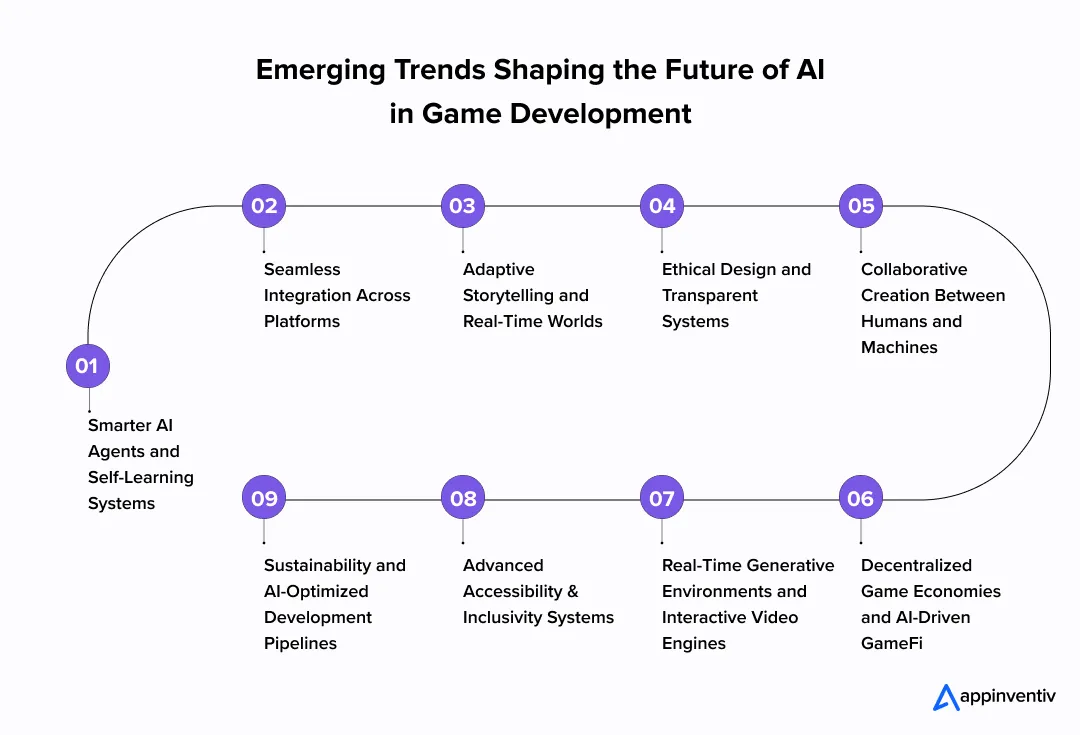
Smarter AI Agents and Self-Learning Systems
AI agents will become more autonomous, learning from player behavior and adapting in real-time. They’ll move from scripted responses toward genuinely dynamic interaction.
Seamless Integration Across Platforms
Expect AI to smooth the differences between mobile, console, PC and cloud gaming. The aim is to deliver comparable experiences everywhere, with optimization handled by AI behind the scenes.
Adaptive Storytelling and Real-Time Worlds
Games will evolve not just through player choice but through systems that change pacing, narrative and environment based on how you play. Worlds will feel more reactive and less pre-designed.
Ethical Design and Transparent Systems
As AI touchpoints grow, players and regulators demand clarity. Studios will need to be transparent about what AI does, how it uses data and how much control players still have.
Collaborative Creation Between Humans and Machines
The role of humans will shift. Rather than being replaced by machines, designers, writers and artists will work with AI as a partner. This balance is crucial for retaining tone and authenticity.
Decentralized Game Economies and AI-Driven GameFi
We’ll see more games where AI handles parts of the economy – marketplace pricing, resource generation, even NPC-driven trading. Games will blur the line between entertainment and the economic system.
Real-Time Generative Environments and Interactive Video Engines
Rather than fixed levels, studios are exploring worlds that are generated on the fly – environments that respond and change as you play, not just when you reload. This is about live generation of terrain, assets and scenarios.
Advanced Accessibility and Inclusivity Systems
AI will do more to adapt games for players with different needs. Gesture recognition, automatic captioning, input mapping and adaptive difficulty will become standard, not extras.
Sustainability and AI-Optimized Development Pipelines
With game budgets rising, AI will help reduce cost and environmental footprint. From asset generation to power-efficient rendering, studios will use AI to make production leaner and greener.
From adaptive design to real-time personalization, we help businesses turn possibilities into playable success stories.
Why Appinventiv Is the Right Partner for Your AI-Powered Gaming Vision
Picking a technology partner isn’t just about outsourcing a project. It’s about finding a team that understands your vision – people who see both the creative and the technical side of what you’re trying to build. That’s what sets Appinventiv apart. We don’t start with code. We start with the idea behind it, who it’s for, what it should make people feel, and how it can move a business forward.
What makes our work strong is the mix of thinking and doing. As a custom AI development company, our teams bring together designers, AI specialists, and engineers who know how to turn abstract concepts into real, playable products. We’ve worked with early-stage founders and established global brands, helping each of them shape something unique. That balance between structure and creativity is what keeps our relationships steady and our products relevant long after launch.
The AI systems we create don’t just automate gameplay; they react, learn, and shape each session based on how people play. Whether it’s a character that adjusts to player style or an analytics layer that reads engagement patterns in real time, every product we build is made to keep the experience fluid, personal, and alive.
As a game app development services provider, we can help companies cut testing time, refine user experiences, and build games that keep improving after launch. From the first prototype to the live version, we stay close to the process, selecting the right tools, setting up clean data pipelines, and training teams to manage and grow their systems independently. The goal is always the same: make AI useful, not complicated, and build products that hold attention for the right reasons because they feel designed, not engineered.
Get in touch with our experts to turn your gaming vision into an intelligent, high-performing product that players remember.
FAQs
Q. How AI is revolutionizing game development?
A. The biggest change is speed and intelligence. What once took months of manual coding now happens in days. Businesses use AI in game development to test new ideas, analyze gameplay, and keep experiences fresh with every update. It’s helping small teams think big and large publishers stay quick. In short, AI has turned game building from a fixed process into something that keeps learning as it grows.
Q. How much does it cost to implement AI in game development?
A. Costs vary, but most projects land between $50,000 and $300,000. A simple game using limited AI logic costs much less than a large title running on adaptive systems or predictive analytics. The AI gaming app development cost also depends on what platforms you’re targeting, how many features use machine learning, and how much post-launch optimization is planned. Think of it less as a single bill and more as a growing investment in smarter gameplay.
Q. How will generative AI change the future of game development?
A. It’s already doing it. Generative tools can design new levels, characters, or scripts without starting from scratch. That means faster production, lower cost, and more creative freedom. The future of Gen AI in game development will revolve around collaboration where businesses will shape the ideas and AI will fill in the details. It’s a shift that makes creation more flexible, not mechanical.
Q. What are the best AI tools for game development?
A. The right tool depends on your goal. Unity ML-Agents is great for training smart behaviors, Unreal’s MetaHuman tool helps build lifelike characters, and NVIDIA DLSS improves performance. Scenario and Inworld AI are useful for dialogue and content generation. The smartest teams mix these AI tools for game development to fit their own workflows instead of following a single template.
Q. Why should gaming businesses invest in AI now?
A. Because waiting means falling behind. Players already expect dynamic content, faster updates, and personalization, all driven by AI. The studios that start early build that muscle first. Investing in AI-powered game development today isn’t about chasing a trend; it’s about staying relevant. It helps businesses release faster, spend less, and keep players engaged in ways traditional pipelines simply can’t.


- In just 2 mins you will get a response
- Your idea is 100% protected by our Non Disclosure Agreement.
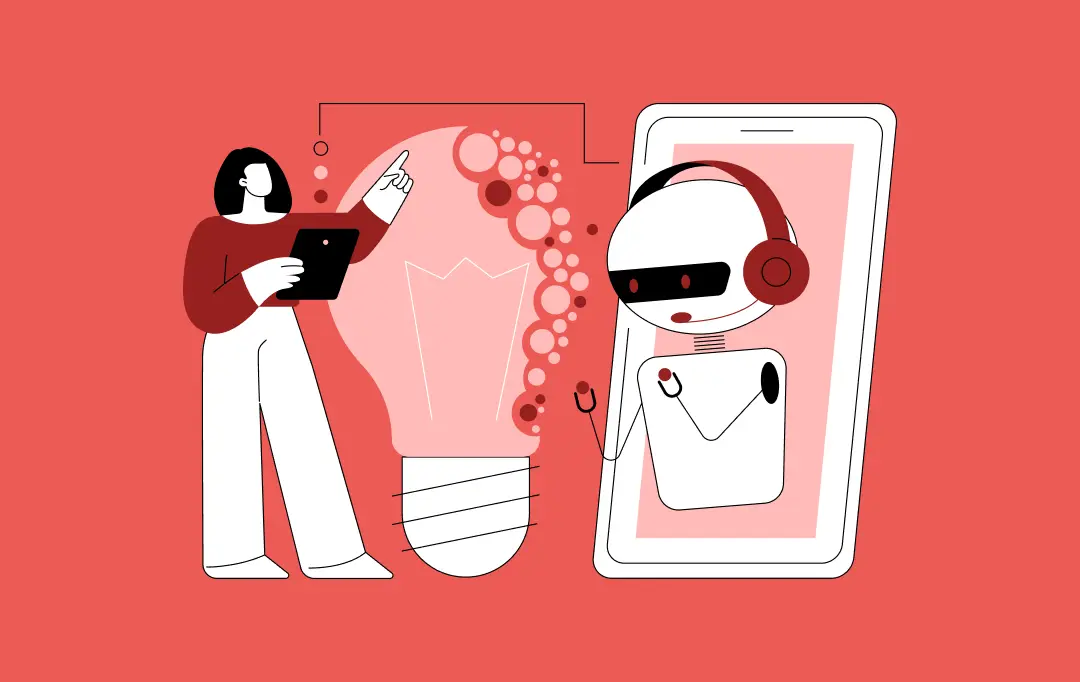
How Much Does It Cost to Build an AI App in Dubai?
Key takeaways: AI app costs in Dubai typically range from AED 80,000 for simple builds to AED 800,000+ for enterprise systems. Dubai is past AI experimentation, and not investing now means catching up later at higher cost. The real budget is driven by data, integrations, architecture, and compliance, not just app features. Hidden costs like…

How AI Tokenization is Enabling Secure and Transparent Asset Ownership in 2026
By 2026, AI tokenization has moved beyond early-stage experiments and pilot projects. Tokenizing real-world assets has become a serious commercial strategy for financial institutions, supply chain operators and technology-driven enterprises. A 2025 report by the World Economic Forum in collaboration with Accenture highlights tokenization as a key mechanism for value exchange in modern financial markets.…

13 Ways Generative AI is Transforming the Hospitality Industry
Key takeaways: The most mature applications of Generative AI for hospitality are in guest service, revenue management, marketing, and operations automation. Real value comes from integrating generative AI into hospitality operations and existing PMS, CRS, CRM, and POS systems, rather than using stand-alone tools. Successful programs treat Generative AI in hospitality as a product, incorporating…
